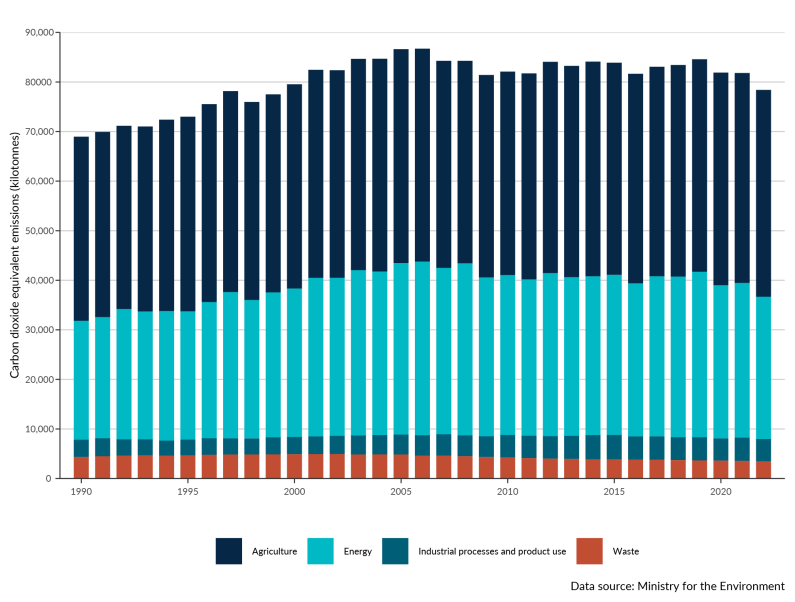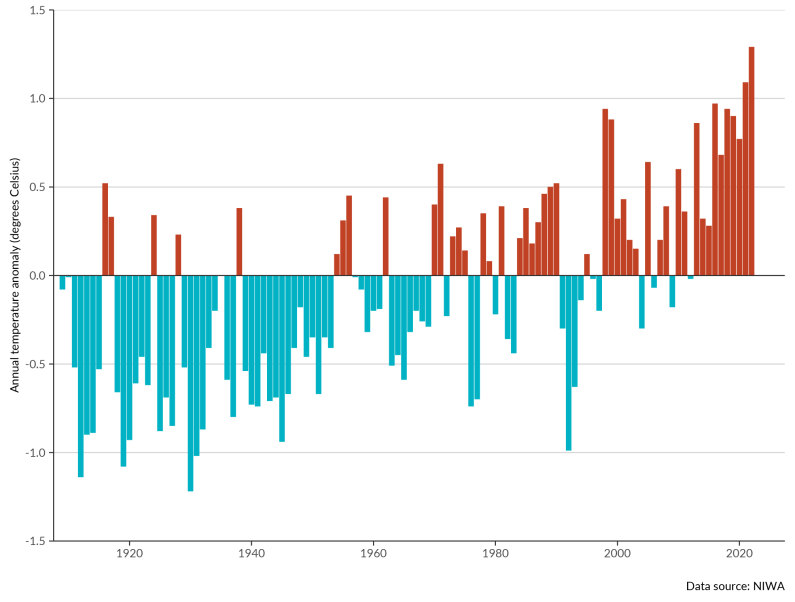6. Atmosphere and climate

Human activities have driven rapid increases in atmospheric greenhouse gas concentrations, causing Earth to warm. The global mean surface temperature was estimated to be 1.1 degrees Celsius above pre-industrial levels in 2011–20. Projections suggest it will exceed 1.5 degrees by 2030 (IPCC, 2023; WMO, 2024). While this may seem like a small increase, even slight rises can drive increasingly significant changes to the natural environment (see Our atmosphere and climate 2023). The 10 warmest years on record have all been in the past decade (2015–24), with 2024 the warmest (WMO, 2025).
In Aotearoa New Zealand, we see rising air and sea temperatures, changing rainfall, more frequent droughts, accelerating sea-level rise, glacial retreat and more frequent or severe extreme weather events. These trends are expected to continue with further warming.
Climate change intensifies pressures and accelerates changes in land, freshwater, marine and air ecosystems. It exacerbates threats such as land degradation, invasive species, resource extraction and pollution. Biodiversity is under pressure from climate change. We see this through changes in where species live, their habitats, their interactions, and in life cycles and seasonal timing. Extreme weather events have direct and damaging impacts on species and ecosystems.
Biodiverse and resilient ecosystems can shield us from the worst impacts, as they absorb some emissions and can provide buffers against extreme weather events and rising seas. Conversely, the continuing loss of biodiversity and degradation of ecosystems weaken their ability to provide these benefits (see Our land 2024).
This section looks at our emissions and how our activities are contributing to an increase in concentrations of greenhouse gases in the atmosphere. It then focuses on our changing climate and how this is affecting the environment.
For the wider consequences, see section 7: Impacts on people, society and the economy.
The 2023 indicator update confirms that atmospheric concentrations of carbon dioxide, methane and nitrous oxide, measured in the Wellington area, increased in the decade up to 2022.
The 2024 update of New Zealand’s greenhouse gas inventory shows that in 2022 our total gross emissions were at their lowest since 1999, but still higher than in 1990. All sectors (except Tokelau) saw reductions in emissions between 2021 and 2022.
Carbon sequestered by land use, land-use change and forestry offset a quarter of our emissions in 2022, compared with 1990 when sequestration by this sector offset about a third of our emissions.
(See Our greenhouse gas concentrations and emissions profile.)
Indicator updates show New Zealand’s average air temperature continues to rise, and most monitored areas are experiencing more warm days and higher growing degree days (indicating longer growing seasons). The frequency of medium-term (agricultural) drought is increasing in many places.
The updates also show that the south of New Zealand is becoming wetter, and the north and east are becoming drier. Maximum daily rainfall is likely increasing across more areas of the South Island, and likely decreasing across more areas of the North Island, and extreme wind is likely decreasing across most of New Zealand. These findings are supported by additional new evidence indicating that extreme weather events are becoming more frequent and severe due to climate change from human activities.
The 2024 update to the national climate projections for New Zealand provides insight into the future state of several climate variables, including temperatures, rainfall, drought and extreme winds.
(See New Zealand’s climate is changing.)
Evidence continues to grow that climate change intensifies pressures on land, freshwater and marine ecosystems, exacerbating threats such as land degradation, invasive species, resource extraction and pollution.
Evidence continues to grow that climate change affects where species live, their habitats, interactions, life cycles and seasonal timing across terrestrial, freshwater and marine ecosystems.
(See Many impacts of climate change affect biodiversity and ecosystems.)
Greenhouse gas emissions from human activities are accumulating in the atmosphere. They are the most significant driver of climate change since pre-industrial times.
Natural influences, such as climate oscillations, can also lead to shorter-term changes over years and decades. However, by increasing the amount of greenhouse gases in the atmosphere, humans are having a significant impact on our climate.

Climate change is causing warmer temperatures, shifting rainfall patterns, more frequent droughts and stronger winds. These changes affect how and when we can grow food, store water or build infrastructure.
The changing climate is also altering natural climate phenomena such as El Niño and La Niña, making extreme weather events more intense. This puts additional pressure on habitats and species, leading to biodiversity loss and ecosystem disruption.


6. Atmosphere and climate
April 2025
© Ministry for the Environment